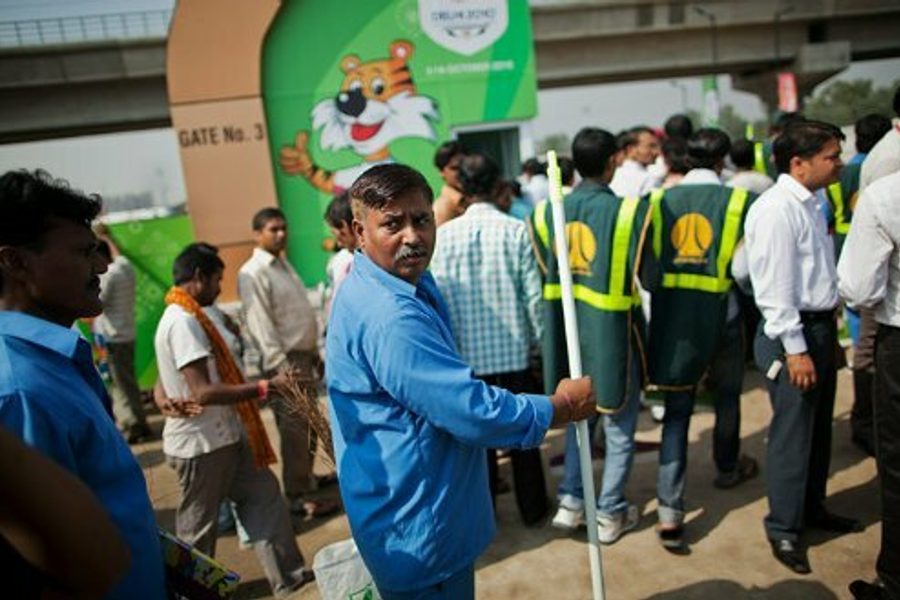
The Commonwealth Games have gotten off to a very rough start. The twelve-day event — a sort of mini-Olympics for countries vestigially tied to the former British empire — has been tarnished by logistical incompetence in recent weeks, scandalizing the host city Delhi and forcing anxious foreign athletes to consider backing out. As the Indian government scrambles to finish preparing the venues, the media have exposed bad plumbing, a collapsed footbridge, and filthy accommodations.
Then there’s the open dirty secret below the surface: the calloused hands of migrants, getting worked to the bone for pennies an hour to meet the October 3 start date. MSNBC.com reports, “at least 47 workers died while working on sites linked to the Games,” according to the tally of the advocacy group Common Cause. Many of the workers that the government cobbled together to set up the city worked for only about half the local minimum wage.
So far, it looks like the games may well go forward as planned — reportedly thanks to some last-minute arm-twisting by the Indian prime minister Manmohan Singh on Thursday. But rights advocates say that wherever the games go from here, the workers have already turned out to be the biggest losers in the botched preparation process.
The bridge that collapsed wasn’t just an eyesore: it wounded 23 workers, leaving five with severe injuries.
The tiniest members of team Commonwealth were recently exposed by CNN International in an interview with trafficking expert Siddharth Kara:
I reliably documented in just a few days 32 cases of forced labor and 14 cases of child labor all for construction related to the Commonwealth Games…
“The children I saw were the ones where I felt I had documented child labor – where children were working, picking up hammers, banging stones, paving entry ways and planting grass along the roads to beautify them, hours and hours at a time….
I documented children aged seven, eight, nine, ten years old working alongside their families in this mad rush to get the construction completed.”
According to a report by the Commonwealth Games-Citizens for Workers, Women and Children Coalition (CWG-CWC), the workforce is emblematic of the vast size, intense deprivation and uncertain future besetting this “emerging” economy’s low-wage workforce:
300,000 workers will be needed for this level of activity, over 3 years, for 300 days/year. Among them will be 100,000 unskilled construction workers, at least 10,000 of whom will be women, and their 20,000 migrant children.
After the athletes go home with their medals, CWG-CWC says, the workers will remain tethered to games’ dubious promises:
The Commonwealth Games are just one part of the bigger construction boom hitting India, expected to grow the domestic construction industry from $70 to $120 billion USD a year by 2012…. The boom is going to generate a huge amount of wealth for many. But if the current trend continues, India’s 32 million construction workers will find themselves no better off in a few years when the boom slows than they do now, meaning they will still be working in dangerous conditions for less than minimum wage without job security, and living without basic living amenities such as maternity and child care.
Kamal Jaswal, director and chief executive of Common Cause, told MSNBC, “This illustrates the dire lot of the construction worker… Particularly migrant workers — petty contractors exploit them to the hilt.”
Yet with Day One approaching, the government seems less concerned with investigating labor abuses than with driving a stream of transient laborers to put the finishing touches on the games’ colorful facilities.
The Commonwealth Games follow a long tradition of colossal sporting events shafting ordinary folks who get in the way. The Beijing Olympics, according to the Geneva-based Center on Housing Rights and Evictions, displaced some 1.5 million residents. Back in 1996, as Atlanta got ready for its Olympic bash, COHRE estimated that “9,000 arrest citations were issued to homeless persons, mostly racial minorities, as part of an Olympics-inspired campaign to, quote, ‘clean the streets’, unquote. Additionally, some 30,000 persons were displaced in Atlanta by Olympics-related gentrification and development.”
South Africa’s World Cup games sparked fierce pride across the continent as well as defiant protests by labor activists, who likened their working conditions to “apartheid.”
The Commonwealth Games of course are set on relatively small scale. But the symbolism behind the event presents the same ironic blend of imperial pride and neoliberal exploitation. In the end, though, it all comes down to a good game.
The games, for now, seem set to go on as planned. With any luck, the organizers may finally breathe a sigh of relief at avoiding further embarrassment. The audience will delight in boxing and table tennis matches, proceeding on schedule, betraying no signs of the ugly toil underlying the facade.
And the child workers scampering around the construction zones will remain well outside the frame of this post-colonial spectacle, obscured by the walls they helped build.
Michelle Chen is a contributing writer at In These Times and The Nation, a contributing editor at Dissent and a co-producer of the “Belabored” podcast. She studies history at the CUNY Graduate Center. She tweets at @meeshellchen.








